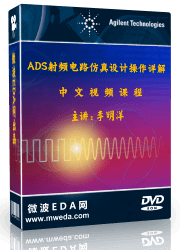- 易迪拓培训,专注于微波、射频、天线设计工程师的培养
[Moved] Complex/imaginary impedance microstrip lines in ADS LineCalc
I am trying to create a microstrip line with a complex impedance. Actually, all of the microstrip lines I am trying to design are purely imaginary (j*some number or -j*some number).
I am not sure if I can just enter these values into LineCalc, because I am getting some awfully small widths when trying to synthesize lengths and widths. I know I can with the Smith Chart Utility, but I'm not sure I can with LineCalc.
Any help would be greatly appreciated!
I think you misunderstood the meaning of the line impedances real part, and want to have a lossless line?
Having a real part of line impedance does not mean that the line has loss. It is just the opposite way: An ideal lossless line will have a purely real line impedance.

I fear it's clear what you are asking about
- the characteristic impedance of a transmission line, which is real for an ideal (lossless) line, as explained by volker@muehlhaus
- the input impedance of a shorted or open transmission line stub, which is purely imaginary for an ideal transmission line
In my class project, I was asked to replace inductors and capacitors in a filter circuit with ideal transmission lines. I replaced them with impedances equivalent to j*omega*l or -j*omega*c. The next step is to design microstrip lines to replace these ideal T-lines. Because the caps and coils are purely imaginary, that's why I need complex impedance microstrip T-lines. Any help would be greatly appreciated!
Lossy transmission line stubs would have complex impedances. Real transmission lines have losses, in so far there will be always a certain real impedance part. But it's small and can be ignored in filter design in a first order.
The only real impedance involved in passive filter design (either LC or distributed) is the source and load impedance. Where do you want "complex impedances" in your filter design? Can you give an example?
You want an imaginary input impedance (Zin) into the transmission line. That is something completely different from the characteristic transmission line impedance (Zline).

Thank you for the guidance. I've emailed the professor with a few of my concerns. I thought each of the five caps and coils should be replaced in ADS with an ideal 2 terminal ideal T-line, but now I'm not so sure. I can't have an imaginary Z0, and I even if I just put in the magnitude of the component's reactance in for Z0, I don't know how to include the -j or j for the phase. It's a fifth order low pass Chebychev filter that I am trying to design. The first step was with caps/coils, second step is to replace the caps/coils with ideal T-lines, and then using LineCalc to design microstrip lines to replace the ideal lines.
I figured 5 caps/coils = 5 ideal T-line sections, each section having a Z0 that equates to the reactance of the cap or coil it was replacing. I'm so confused...but appreciate the insight thus far!
You can, and only your approach of converting the impedance to the line paramaters is wrong. Once again: the line impedance Z0 is not equal to the impedance of your L or C. That's where you misunderstand the design method.
Please have a look here:
http://books.google.de/books?id=-GC9...20line&f=false
http://www.rfcafe.com/references/ele...components.htm
申明:网友回复良莠不齐,仅供参考。如需专业帮助,请学习易迪拓培训专家讲授的ADS视频培训课程。
上一篇:Drawing simple Data in Smith ADS smith Chart
下一篇:Keysight ADS significant discrepancy between circuit simulation and Momentum 11 GHz
ADS娑擃厽鏋冪憴鍡涱暥閸╃顔勯弫娆戔柤 | More...
 国内最全面、最专业的Agilent ADS培训课程,可以帮助您从零开始,全面系统学习ADS设计应用【More..】
国内最全面、最专业的Agilent ADS培训课程,可以帮助您从零开始,全面系统学习ADS设计应用【More..】
- Agilent ADS教学培训课程套装
- 两周学会ADS2011、ADS2013视频教程
- ADS2012、ADS2013射频电路设计详解
- ADS高低阻抗线微带滤波器设计培训教程
- ADS混频器仿真分析实例视频培训课程
- ADS Momentum电磁仿真设计视频课程
- ADS射频电路与通信系统设计高级培训
- ADS Layout和电磁仿真设计培训视频
- ADS Workspace and Simulators Training Course
- ADS Circuit Simulation Training Course
- ADS Layout and EM Simulation Training Course
- Agilent ADS 内部原版培训教材合集








